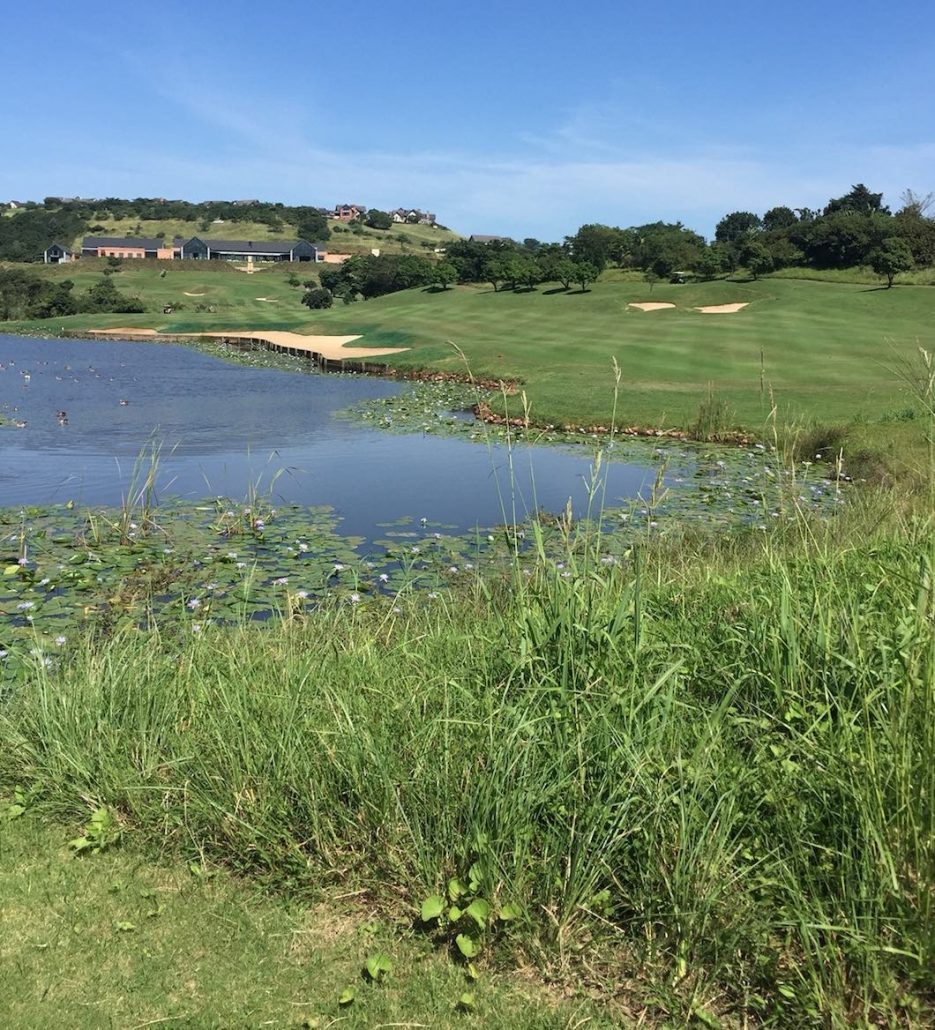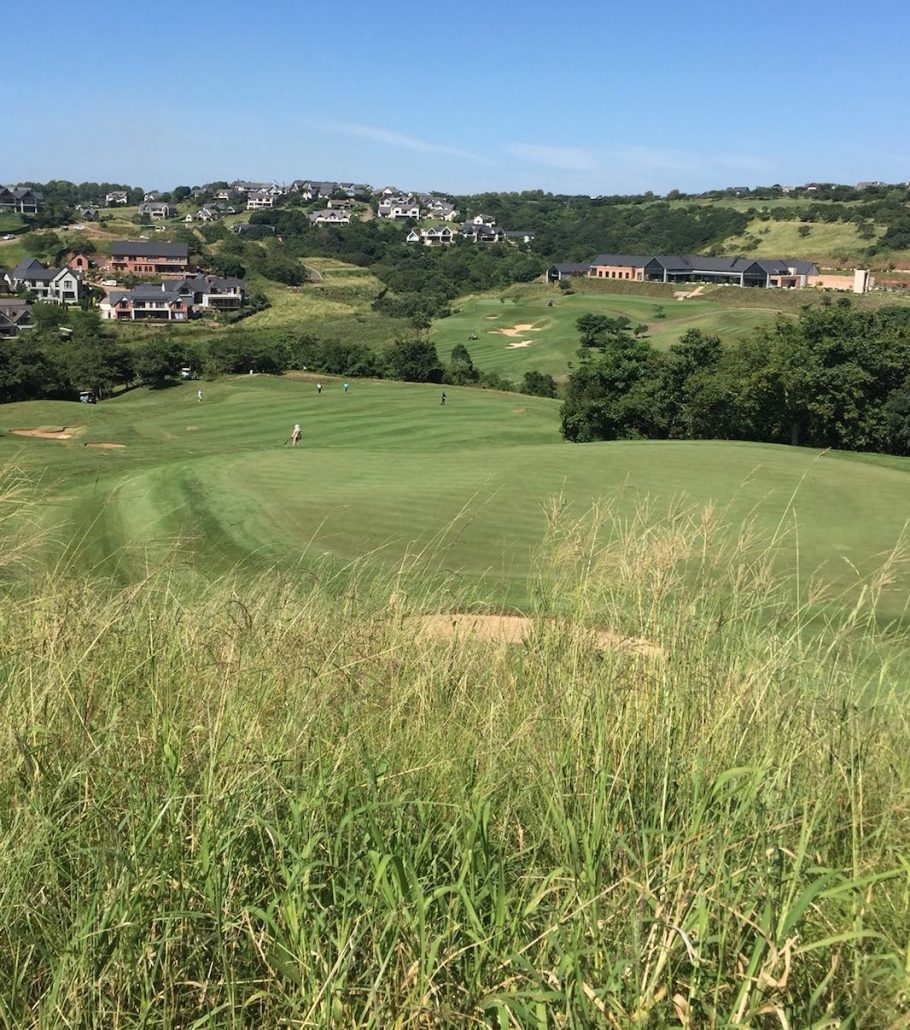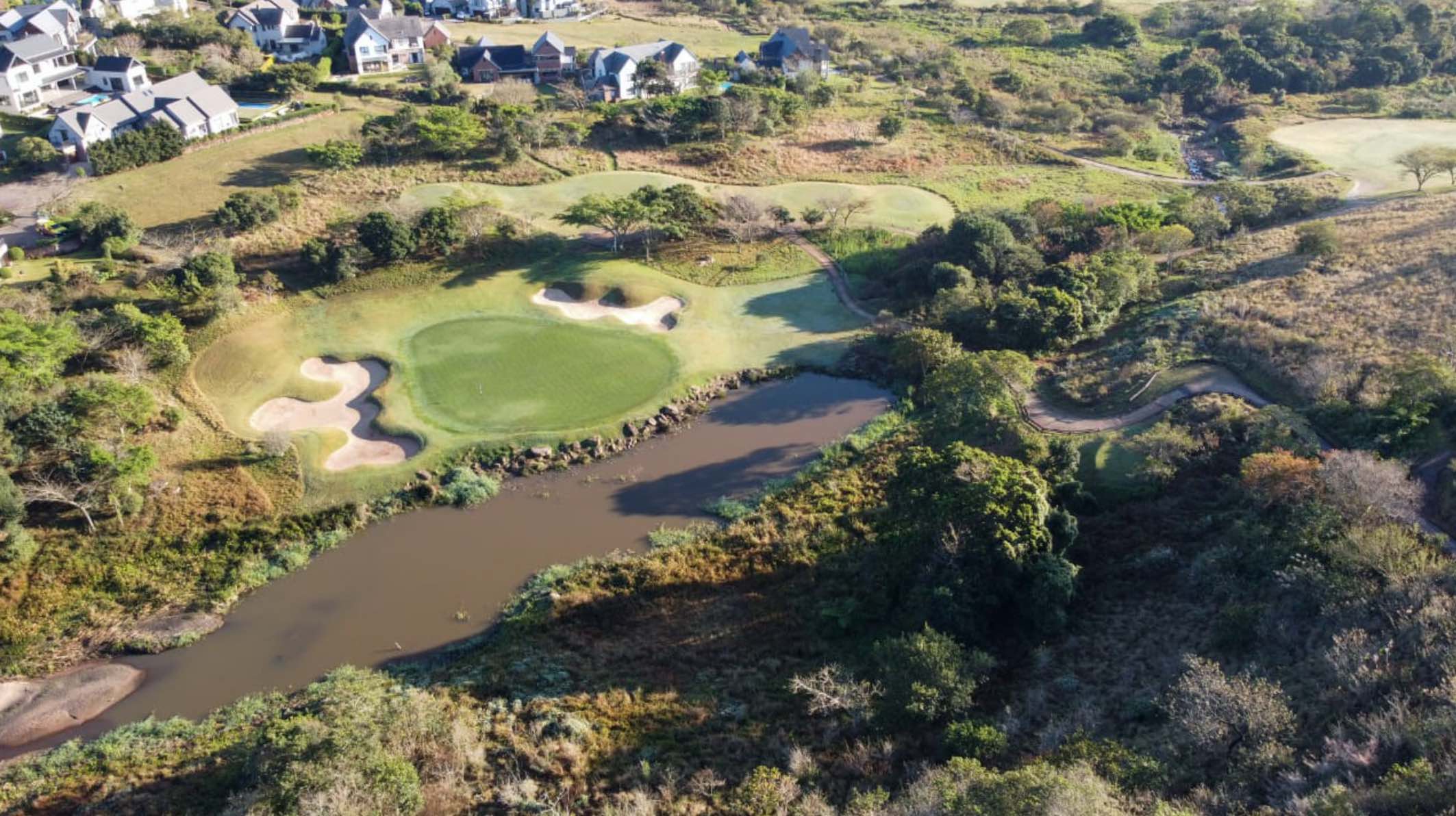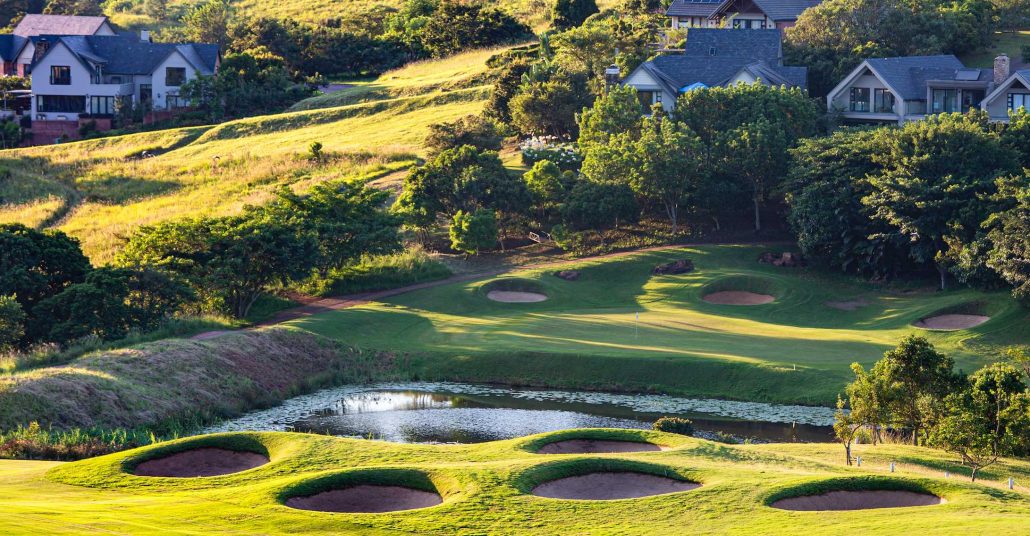If you are looking for a big course to play in greater Durban, look no further than Cotswold Downs estate, writes SIMON OSLER.
The Cotswold Downs estate is on the outskirts of Hillcrest in the mist belt some 600m above sea level. Top course designer Peter Matkovich created a stunning USGA-rated championship course across valleys and streams, superbly blending it in with all the natural surroundings. It opened in November 2006.
From the usual club tees it is about 250-300m longer than most of the top South Coast courses when they are played from the tips … And the championship tees at Cotswold add another 500m on to those distances. At a cumulative 6,700m from the tips (to the front of each green), add an average of 20m to the middle of each green and you are looking at more than 7km of course. The course rating reflects its difficulty too, at 75.6, with a slope rating of 143. The club tees offer a more manageable 6,241m walk.
The undulating nature means it is strictly played from carts. There are also a few lengthy treks from green to tee. With wide open fairways and hardly a tree in play, there’s lots to inspire confidence in players to open their shoulders and have a go with their drivers. Being long off the tee will be a huge advantage.
The bent-grass greens are among the largest in the province and there’s plenty of slope on most of them. Depending on the pin position your club selection may differ by as much as three clubs. Given that the greens are cut short all year and range from fast to very fast, three-putts are not uncommon, especially if your ball has landed in the ‘wrong’ quadrant of the green.
Let’s play our way around.
The round starts with a hole that plays about 500m from the club tees to the middle of the green; it’s a sweeping right-to-left three-shotter for all but the longest of players.
The fairway slopes severely from right to left, so aim at the left edge of the two deep bunkers on the right edge of the fairway that are just reachable for the average hitter. Your ball should roll back towards the middle of the fairway. In winter when the grass is short your ball may roll all the way down and into the very long bunker that runs along a significant portion of the left-hand side of the hole.
About 180-200m ahead, and in your eye, is a large tree on the left edge of the fairway as it pinches narrower. You can aim further right than you think, as there’s quite a bit of space in a bit of a blind spot. If you catch the slope forward your ball may run an extra 40-50m and come to a halt just short of a conservation area about 50m short of the green.
The tiered putting surface has three distinct areas where the pin is usually placed. You want to leave yourself below the pin in any of them (that applies to everywhere on the course!) to reduce the chances of having a three-putt.
While the opening hole offered a wide open fairway and a chance to bomb it off the tee, there’s no doubt that the 2nd hole places a premium on accuracy. An aiming pole in the middle of the fairway is the perfect sightline. Go left and you will be in the bush; go too far right and you bring a steep bank with long savannah-type grass into play.

From the aiming pole you should have around 180m remaining. Your approach shot sees the large green about 35m below the level of the fairway. Selecting the right club is essential as there’s water short and left, then bunkers short. Long is absolutely no good. There’s a bail-out area on the right but avoid the large area of long rough just short of it. Plenty of pin positions are offered on this green which has quite a bit of slope towards the water. If you are lucky you may see a monitor lizard soaking up some sunrays on the banks of the pond, or even chasing some of the waterfowl.
The 3rd plays significantly uphill again. The fairway is very wide and is protected down both sides by bunkers which are unlikely to be in play off the tee for the average golfer. Your approach shot to the inverted saddle green is at least 25m above the fairway and the low centre section has a false front which if not carried will see the ball rolling back down the fairway.
Your tee shot on the 4th is across a ravine but it’s not a long carry. This fairway is one of the harder ones to hit and the bail-out area on the right is where a lot of people will play their approach shots from. Lots of well-disguised slope on the vast green has occasionally seen this hole as the stroke two, although it’s currently rated as the 10th-hardest hole on the course.
Then on to the signature hole, the par-three 5th (see p61).
The 6th hole is the shortest par four on the course at 294m from the club tee. The green is narrow and there’s lots of trouble on the left, with a very deep bunker and then a conservation area waiting to snare those pulled shots. There are also half a dozen pot bunkers down the right side of the hole. The safest option is a hybrid or 5-iron to the wide section of the fairway and leave yourself a wedge to the green. Don’t go long, though, as there’s trouble behind the green too. I can recall that at one club championship I played, an ace was recorded on this hole. Definitely one to consider as a birdie opportunity.

The 7th plays a club uphill. Most of the green is hidden behind the mound which prevents a great shot, or hole-in-one, from being seen from the tee.
Next up is the hole that was the first stroke one, when the course opened. It’s not that difficult but it is long. One should not miss the fairway, which is wide enough to land a jumbo jet on. The second shot will see most social players hauling out the 3- or 4-wood. The hole plays significantly uphill, and the ball will probably be a little below your feet (for a right-hander) which should help promote the desired baby fade to the green. Hit it too far right and you will have a 30 or 40m chip from down in the valley.
The final hole on the front nine is a long (is there any other type on this course?) par five. Again the elevation change is huge and your tee shot from the elevated club tee plays sharply downhill towards a small stream which runs across the fairway. It’s only in play for the bigger hitters off the tee but the average player can hit his driver in the knowledge that he will be 50-100m short of the water.
Going for the green from there is not an option unless you can manage a 250m 3-wood slightly uphill and almost always into the wind. So a mid-iron towards the left bail-out area, and then wedging it close on the big undulating green will be your best chance of a birdie here.
Time for a well-earned 15-minute refuel at the excellent halfway-house spot in the clubhouse, where the food is always good, the coffee enticing and the beers chilled.
Your restart on the 10th, a sharp dogleg left, is over a ravine to a steep fairway guarded by bunkers up the right. You will have a short second shot to the three-tiered green and it requires precision – remember the rule: leave yourself an uphill putt. If you are out of position on this green, a three-putt is almost inevitable.
The 11th is another short par four that requires an accurate tee shot to avoid the bunkers on the corner of the slight dogleg right. There’s plenty of space left of the bunkers and the safe play is to go long and slightly left.
The 12th is the highest point on the course and runs due east, usually into the prevailing winds. This is a great hole with cross-bunkers at driving distance leaving what looks like only a sliver of fairway to their left. Thread it past the bunkers and you are left with a short-iron into an elongated green which is protected by a handful of pot bunkers.
The 13th is a par five that for the average player is relatively easy to play in par (it is stroke 13) but is very tough to birdie. Probably the biggest green on the course means there are plenty of pin positions available. Most of the slope on the green is towards the dam on the left of the hole.
The 180m par-three 14th is a bit of an anomaly on this course – it’s almost dead level. The biggest elevation changes are on the large green itself. Par is always a good score on this hole.
Completing the run of three massive greens is the 15th, a slight dogleg to the left. It’s another super design with well-placed bunkers, and a sloping fairway. A good drive is well rewarded.
The final par three is the 150m 16th which is played to a comparatively narrow green. A front pin placement makes it easy to walk away with a par, but the further back the pin, the tougher it becomes.
The final two holes regularly vie for the title of ‘toughest on the course’.
The 17th tee is perched on the top of the escarpment looking down on a fairway 50-60m below. Being a sharp dogleg right, a tight line down the right is good, but just stay out of the handful of pot bunkers on the elbow of the hole. Further right brings the out of bounds into play. The further left you go, the longer your second shot will be … and leaving a 190m carry over the river which runs in front of the green will not be a comfortable shot for too many players.
The par-five 18th is a test of course management and confidence. From the club tee there’s a huge dam straight in front, so aim at the ‘butterfly’ bunker on the right with a draw. Then comes the decision-making time – with the ball above your feet, do you risk trying to clear the conservation area up ahead with a 180m wood and leave a wedge in, or do you lay up and leave a 6-iron to the raised and multi-tiered green? The decision is much easier when playing from the championship tee: if you can reach the fairway with your drive you can hit 6-iron twice to reach the green.
Finished? You have definitely earned those cold drinks back at the clubhouse as you sit down and dissect your round on ‘Matko’s Masterpiece’.
SIGNATURE HOLE
7th hole, 156m, par three

This short hole is one of the most picturesque in the country. In fact, the panoramic view from the club tee is even better than that from the championship tee.
The tee is perched on the edge of the cliff-top overlooking the valley, with the green about 60-70m below. While the distance from the club tee is 156m, the hole plays about three clubs less. So whatever you are comfortable hitting a distance of 135m, that’s the club you need to find the middle of the huge oval green.
When the pin is in the bowl at the back, take an extra club and you should be spot on. The bank at the back is a useful backstop and will bring the ball back towards the green.
If the pin is on the front of the green, don’t get greedy or you might bring the river into play.
There are also large bunkers guarding the sides of the green which come into play if you have hooked or pushed your tee shot.
Gravity often plays a part in seeing balls plug on landing as tee shots are regularly descending from a height of 100m or more on to a very soft green.
There is a ‘hole-in-one-challenge’ running there, and for a fee of R30 (a portion of which goes to a local charity), payable on check-in, you can be included in the event. The remote cameras that are set up will record your attempt and result at the hole. The jackpot grows at an incredible rate and a winner in January walked away with about R396 000. At least he was able to settle his bar bill!
With plenty of tees available, this hole can play anywhere from 80m to 180m. From the championship tee a few years back, during club champs, I hit it to less than an inch from the hole, and from the club tee a couple of years ago was again within six inches of the perfect fluke. But I have seen some of the Sunshine Tour pros, when they were just starting out on their careers on the IGT Tour, not being able to judge the hole from the forward tee and hit a shot of less than 85m.
GREENFEES
Full members: R450
Senior members: R390
Visitors:
Monday-Thursday: R530
Friday, Saturday, Sunday and public holidays: R775
All prices are for a full round of 18 holes of golf and include a golf cart to get around the course.
ROAD DISTANCES
Pretoria: 604km
Johannesburg: 545km
Durban: 36km
Bloemfontein: 613km
GETTING THERE
From King Shaka International: Get on N2 from M65. Follow N2, N3 and King Cetshwayo Highway to Old Main Rd/R103 in Gillitts. Take exit 28 from King Cetshwayo Highway. Continue on Old Main Rd/R103 to your destination in Cotswold Downs Golf & Country Estate.
GPS CO-ORDINATES
S29.7506”, W30.7939”
ADDRESS
95 Inanda Road
Hillcrest
3650
CONTACT DETAILS
(031) 762 3655
WEB DETAILS
– This article first appeared in the September 2022 issue of Compleat Golfer magazine.









